This is the complete guide to becoming a personal trainer in 2024. Learn everything you need to know to embark on this career path, make a name for yourself, and fill your roster with happy clients.
In this guide, we’ll discuss:
- The necessary skills for personal training
- Salary and job outlooks
- How to pick the right certification
- How to start work in the fitness industry (the five crucial steps you must take)
- Expanding your client roster and building your reputation
- The value of experimenting
- Specialization and career advancement options
- How to stand out
And a lot more, so let’s dive in.
Chapter 1: Personal Training Fundamentals
This chapter covers some fundamentals you should know before becoming a personal trainer. It will help you better understand what the job is, what you can expect, and what skills and qualities you should work on to be successful in the long run.
We will also briefly look at job outlook and salary expectations.
What is a Personal Trainer?
A personal trainer is someone who creates fitness assessments, writes training plans for clients, guides them through individual workouts, and provides feedback.
Some common practices in personal training include assessing a client’s mobility, cardio, and strength, monitoring training form, and providing helpful tips on how to move safely and more efficiently.
Personal trainers are also responsible for setting realistic expectations for clients to better understand what they can achieve in the short and long run.
Simply put, a personal trainer guides clients through the complexities of fitness, teaches them the fundamentals, and helps them learn how to self-correct when they eventually become independent.
How Long Does it Take to Become a Personal Trainer?
It generally takes 3 to 6 months to complete the coursework and pass your CPT exam.
However, the exact duration will depend on the program you enroll in (we’ll break them down in Chapter 2), how much time you spend preparing, and how much knowledge you have at the start.
Once you earn a certification, you will probably have to complete an internship lasting anywhere from 4 to 12 weeks before you start working with clients independently.
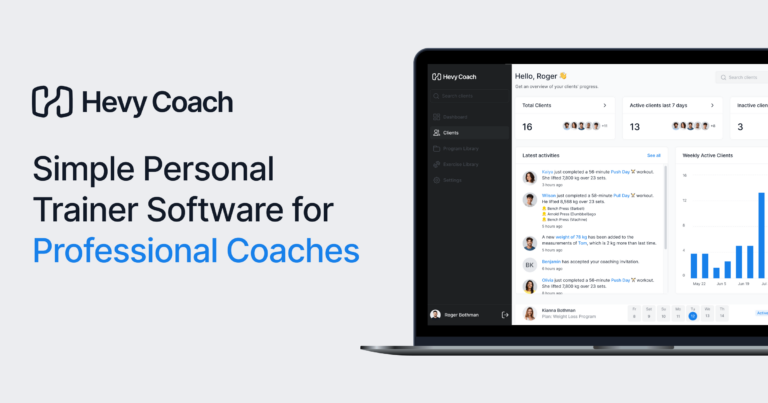
Try Hevy Coach
Intuitive personal trainer software, with a world class experience for your clients.
30 day free trial, no credit card required
How Much Does it Cost to Become a Personal Trainer?
The average personal training certification program costs around $1,000 and includes study materials and one or two shots at the final exam.
Some programs, such as NSCA, have an exam-only package, but you must find and buy the study materials independently.
Recertification typically happens every two to three years and generally comes at a fee of around $100.
You will also have to spend some money on approved courses to collect the necessary continuing education units (CEUs) to be eligible. We’ll break down the whole process in Chapter 6.
How Does Personal Training Work?
You will spend long hours in the gym and around training equipment as a personal trainer. Some of your tasks on the job will include:
- Guide clients through the gym
- Teach them what different pieces of equipment are for
- Prepare the equipment for them to use
- Explain how to set up, perform movements, and stay safe
- Demonstrate various exercises
- Teach your clients essentials like scapular retraction, hip hinging, and squatting
- Monitor your clients while training
- Provide actionable feedback
- Tell them when to stop doing a set and take a break
Though not necessarily requirements, you will likely have to debunk myths (For the last time, Matt, protein is not a steroid.) and explain to clients some of your decisions (e.g., why combine specific exercises).
The above applies to traditional in-person coaching, but many of these also apply to other forms of personal training, such as:
- Hybrid personal training (where you meet clients in person once in a while but typically coach them online)
- Semi-private training (where you work with two to four clients at a time; this is a more advanced tactic not suited for beginner personal trainers)
- At-home personal training (where you visit clients at their homes or have them come to your home for training sessions)
As a new personal trainer, it would be best to stick to the traditional approach to build the necessary skills before branching out to online coaching or working with multiple clients at a time.
Regarding schedule, personal training can be flexible, and you will likely have some free time during the day (especially from 12 to 3 PM). You will likely have more sessions from morning until noon (6-7 AM to 12 PM) and from the late afternoon until the evening (4 to 7 or 8 PM).
What Skills Does a Personal Trainer Need to Have?
Educating clients on physical fitness can be a considerable challenge because everyone starts from a unique place, learns things at an individual speed, and progresses at a unique rate.
Because of that, one of the most valuable qualities of personal trainers is patience. You may be experienced and knowledgeable, but remember that you were also once a beginner.
Trying to rush clients through the process is not good for you or them because it leads to feelings of inadequacy, making your clients think they are not cut out for the whole ‘fitness’ thing.
So, as you embark on this career path, understand that you may have to spend more time teaching the basics, and you will likely need to develop better ways to simplify complex topics and make everything more understandable for people.
Other skills and qualities you should have include:
- Empathy to see things from their point of view
- Flexibility to adapt and change course as necessary
- Communication skills to build rapport and establish relationships
- Time management to create a good balance between education and working out
- Adaptability to better connect with different clients and adapt the necessary approach
- Nutrition knowledge to guide clients better (more on this in the certification section)
Being tech-savvy is also valuable nowadays, as it allows you to take full advantage of the best personal training tools.
For example, you may start with a basic approach, but you can eventually adopt a tool like Hevy Coach and use it to create programs, assign them to clients, and track their progress from a dashboard.
Salary and Job Outlook for Personal Trainers

As with any profession, entry-level positions pay less, but growth potential depends on your location, place of employment, and ability to serve clients well and solve their problems.
According to this report, the average personal trainer salary in the US is $45,095 per year or $27.86 per hour. Washington, Indianapolis, Chicago, and New York are some cities with the highest earnings potential for personal trainers.
That said, personal training is one career where you can earn far more than average, especially if you specialize, offer additional services, and build a presence online—more on those in Chapter 6.
Given that job security is also crucial, personal training is a viable option where the demand for professionals is projected to grow.
According to the US Bureau of Labor Statistics, employment for trainers and instructors is likely to grow by 14% from 2022 to 2032, far higher than the average for other occupations of just 3%.
Chapter 2: Certifications and Prerequisites
This chapter dives into the nitty-gritty of personal training certifications, overviewing the best options for aspiring professionals, along with pricing information and what course is ideal based on your goals.
Things Needed to Become a Personal Trainer
Becoming a personal trainer is not as complicated as some may think, but there are a few requirements:
- Be 18 or older
- Have a high school diploma or a GED (high school equivalency diploma)
- CPR/AED certification
- Personal training certification (more on those in the next point)
The first two are self-explanatory and likely not to be an issue.
Then, we have a CPR/AED certification, which requires you to complete a course in several hours and pass an exam. It costs up to $60 and lasts for two years.
The last thing is the personal training certification, which will cost more and take longer, but we’ll break it down below.
An In-Depth Look at Personal Training Certifications
Personal training certification programs are designed to prepare aspiring fitness professionals for a career in the industry. It provides people with essential knowledge and expertise to start work as personal trainers.
Depending on the personal trainer certification, you can expect more or less emphasis on certain things, so it’s best to do some research before enrolling.
For instance, ACE is one of the popular and respected certification programs, but a common complaint from students was that the course didn’t place as much emphasis on resistance training and teaching proper form as it should have.
However, they’ve since updated their course and now focus far more on teaching effective resistance training and programming that works in the real world.
With that in mind, let’s look at six of the most popular options:
American Council on Exercise (ACE)

- The time it takes to complete: 3 to 6 months
- The starting cost: the basic package costs $675
- What’s included (basic package): access to ACE University, one practice test, digital copies of the ACE personal trainer textbook and ACE PT study companion, and one shot at the certification exam, which you can take from home
- Difficulty of the final exam: one of the more difficult CPT exams; the pass rate is around 65%
- Who it is best for: people who want a more prestigious personal training certification that increases the chance of landing a good job
American College of Sports Medicine (ACSM)
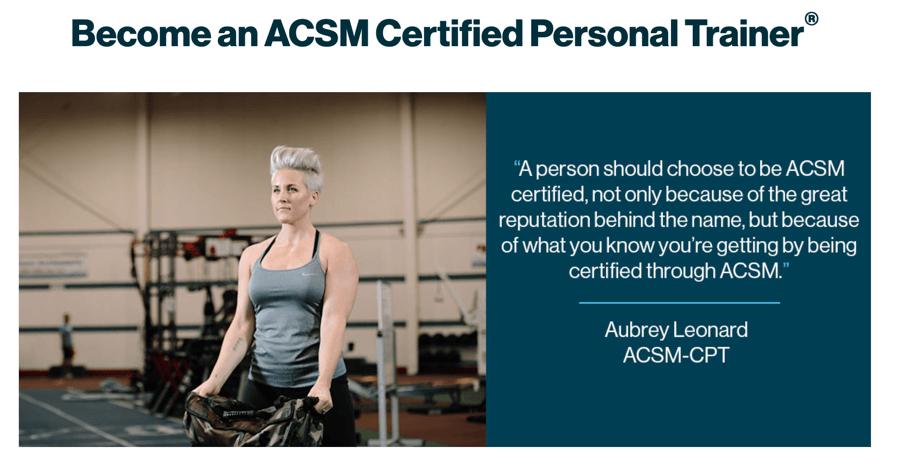
- The time it takes to complete: 3 to 9 months
- The starting cost: $999+ ($600+ for the study materials and $399 for the exam for non-member candidates)
- What’s included (basic package): curriculum study preparation, CPT prep course (19 modules and 453 lessons), over 200 practice questions, and access to the ACSM CPT Facebook group
The relevant ACSM textbooks (Resources for the Personal Trainer and Guidelines for Exercise Testing and Prescription) are not included, and you’d have to spend an extra $130+ to get them if you want. - Difficulty of the final exam: quite challenging to pass as it takes you through the whole ACSM textbook; the pass rate is around 68%
- Who it is best for: trainers who primarily want to focus on clinical populations and those who plan on specializing further in other ACSM courses
International Sports Sciences Association (ISSA)
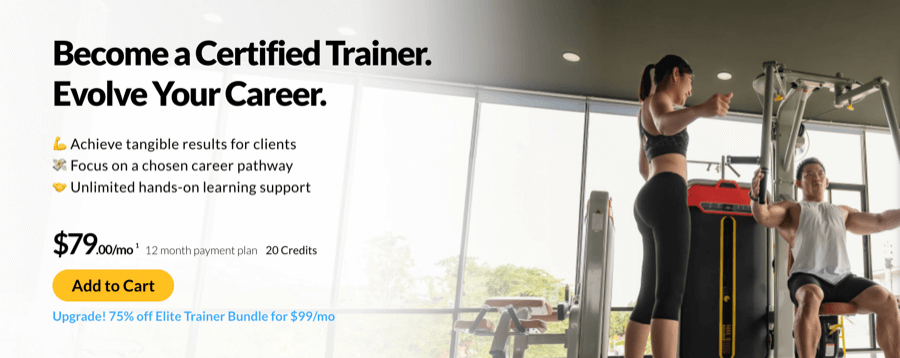
- The time it takes to complete: 3 to 5 months
- The starting cost: $999 (can be paid in 6 or 12 installments of $166,50 or $83,25, respectively)
- What’s included (basic package): study guide, digital textbook, exercise library, quizzes, access to an online forum, new trainer guide, and a final exam
- Difficulty of the final exam: it’s generally one of the easier to pass (however, you still need to prepare, as the failure rate is 10%)
- Who it is best for: personal trainers who want to gain a solid foundation of knowledge and potentially work with special populations (it’s also fantastic for coaching the general public)
National Academy of Sports Medicine (NASM)
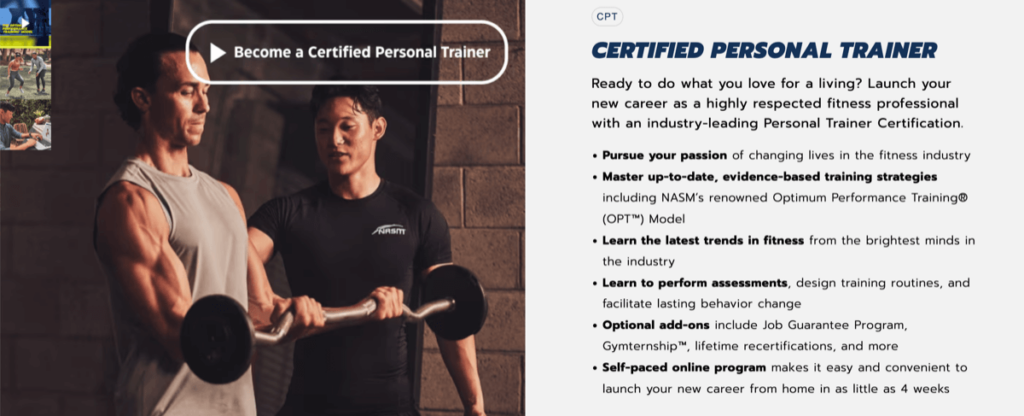
- The time it takes to complete: 3 to 6 months
- The starting cost: from $899 (can be paid in 12 installments of $75)
- What’s included (basic package): access to a digital learning platform, learning videos, exercise demonstration library, resources library, biodigital 3D models, a practice exam, and quizzes
- Difficulty of the final exam: consists primarily of multiple choice questions, but it’s generally difficult, with the pass rate hovering around 65%
- Who it is best for: aspiring personal trainers and those who plan to specialize further and complete other NASM courses (such as for nutrition coaching credentials)
National Council on Strength & Fitness (NCSF)
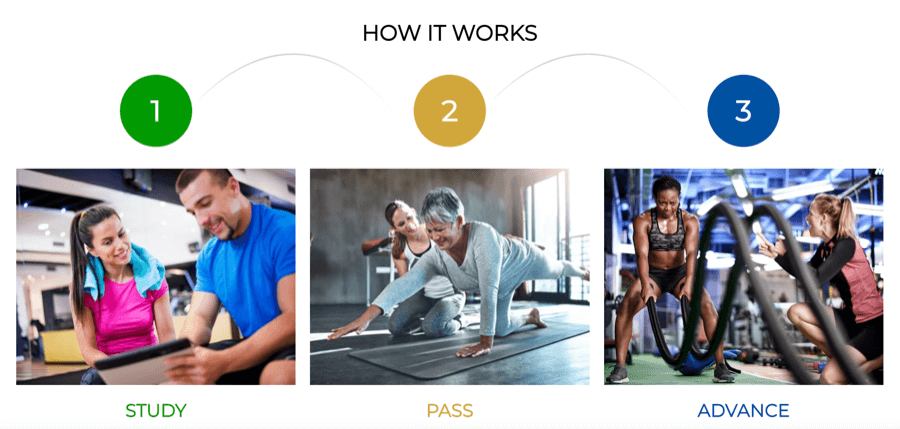
- The time it takes to complete: usually 2 to 3 months
- The starting cost: from $799 (but it’s often discounted and currently goes for $399); there’s also an exam-only option for $299
- What’s included (basic package): personal training textbook, instructional videos, quizzes (300 questions in total), NCSF membership for a year, and a CPT exam
- Difficulty of the final exam: generally not that hard, but you still need to prepare; the pass rate is approximately 75%
- Who it is best for: great for most trainers, especially those looking to get an NCSF nutrition coach certificate (one of the best in the industry)
National Strength and Conditioning Association (NSCA)
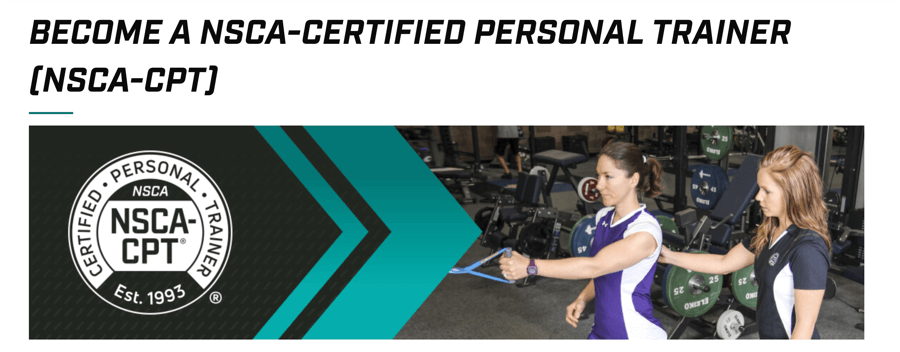
- The time it takes to complete: 6 months
- The starting cost: $435 registration fee for the exam for non-members
- What’s included (basic package): there aren’t any packages; you can purchase the study materials outlined on this page for approximately $435 ($359 for NSCA members)
- Difficulty of the final exam: the exam is generally considered to be easier than others, but the pass rate is around 77%, which means almost one in four people fail
- Who it is best for: trainers looking for well-rounded study materials to gain broader knowledge and expertise; it’s also ideal for people passionate about exercise science
Which One Should You Pick?
Each of these programs is good and provides a certificate that carries weight and opens doors in the fitness industry. You should go with the one that best fits your needs, study preferences, aspirations for career advancement later, and budget.
ACE currently stands out as a great option with an affordable basic package, well-rounded educational materials, and certifications that open doors.
That said, ISSA and NASM may be more expensive, but they also offer payment plans that make them more viable.
Why We Recommend a Nutrition Degree or Certification
Earning a personal training certification is the first step to becoming a coach. However, that alone may not be enough, as working out is one part of the equation.
For optimal results, your clients must also take care of their nutrition, and you should be the person to teach and guide them. That way, all their fitness guidance comes from one source, and you can create training and nutrition plans that work together.
The alternative is for the client to get exercise programs for you and seek nutritional advice elsewhere, which can create some problems. Most notably, your client may go on a diet that doesn’t align with their training objectives.
For instance, you may create a muscle-building workout plan for a client. But if they follow a low-calorie, low-protein diet, your plan won’t work for them. That may make it seem like your training guidance is the problem.
Earning a nutrition certification would allow you to provide all the guidance your client needs, leading to better results, greater satisfaction, and more testimonials (more on those below).
Plus, you can earn more money from each client and reach your earnings goals with fewer clients on your roster.
The great thing about PT and nutrition certifications is that you can find bundle offers to save money. For instance, ACE, NASM, and ISSA offer such bundles at reasonable prices.
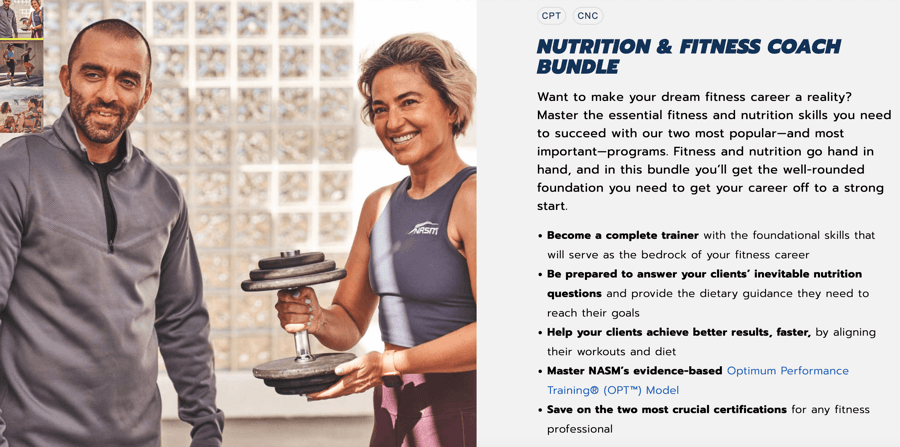
Chapter 3: The 5 Crucial Steps to Take
This chapter outlines the five steps you must take to go from an aspiring fitness professional to a practicing personal trainer.
Step 1: Enroll in a Certification Program
Assuming you’re 18 or older and have a high school diploma or a GED, you can enroll in a certification program and start studying for the CPT exam. Even if you don’t have a CPR/AED certification, you can receive it from ISSA in a day without leaving your home.

You may need time to consider which certification program would be ideal. That will largely depend on your aspirations and where you want your fitness career to go.
Let’s briefly recap some options from the previous chapter:
- For general personal training (you want to start as soon as possible, and you’re not entirely sure how you may advance down the road and what specialization you may seek) – NSCA and ACE are excellent options.
- For trainers looking to specialize (e.g., study sports medicine later and work with special populations, such as older people) – ISSA, NASM, and NSCA.
- For trainers who want to earn a nutrition certification (highly recommended) along with their PT certification – ACE, ISSA, and NASM.
Step 2: Study for Your CPT Exam
As a fitness enthusiast, you may feel the final exam will be easy to pass. After all, you probably watch YouTube educational fitness content, follow folks like Layne Norton on Instagram, read StrongerByScience in your free time, and maybe even catch some podcast episodes related to personal training.
While these things are great and could help you score better, it’s important to note that each exam presents unique challenges and often phrases questions in a way that makes the most sense if you’ve gone through their specific study materials.
According to our findings (discussed in the previous chapter), the pass rate on the final exam for most popular CPT programs is around 65-70%. This means at least three out of ten people who take them fail.
So, even if you feel confident (there’s nothing wrong with that), get the recommended study materials and go through them. In addition to preparing yourself, you might learn some valuable insights that could benefit your personal training practice later.
Most certification programs offer study materials (typically as digital downloadables and as access to study platforms). Alternatively, pay the fee for the final exam only, research what the study materials are, and try to find them used.

Try Hevy Coach
Intuitive personal trainer software, with a world class experience for your clients.
30 day free trial, no credit card required

You can also opt for the main textbook (for example, ACSM’s textbooks Resources for the Personal Trainer and Guidelines for Exercise Testing and Prescription will set you back about $130-140).
That’s a good option if you generally learn well from textbooks and don’t mind getting all the info in written format.
(Keep in mind that textbooks are generally not ‘light’ reads and require some basic knowledge to understand.)
As you go through the study materials, complete your practice tests to see where you stand and what knowledge gaps you may have.
The good news is that you can retake an exam even if you fail. For instance, ISSA gives you two shots to pass the exam, with each additional attempt costing $99 (valid until the expiration date of your course).
Step 3: Get Liability Insurance
Liability insurance is one of those things you may never need to use but should have nonetheless. It protects you from dissatisfied clients who may claim that your guidance has been ineffective or has put them in danger.
For instance, if a client gets injured on a training program you’ve created and decides to sue, this insurance protects your assets. This is important even if you work at a gym instead of running your own business.
We recommend getting insurance before seeking employment as it demonstrates professionalism and preparedness, which leaves a good first impression on recruiters.
Plus, having insurance might be required for you to start work. Also, you have legal protection from day one.
You can learn more about insurance for personal trainers (including other types and when it makes sense to get them) in our guide.
Step 4: Create a Resume and Seek Employment
Earning your certification is an impressive accomplishment, but your job isn’t finished. The next step is creating (or updating) your personal trainer resume.
A resume is simply a summary of you as a professional. Your future clients likely won’t read or care about it, but potential employers will.
Don’t worry, though. Writing one isn’t that difficult, and you can still make yours impressive, even if you’re just starting your fitness career. Include the following:
- Professional summary – one paragraph about who you are, your certifications and degrees, your experience, past achievements, and your skill set.
- A list of your skills and competencies – in bullet format, outline precisely what you can do (e.g., write tailored training plans)
- Experience and work history – this is an important one, but you may not have much to add (after all, you’re just getting started); in this case, you may simply write, “Please refer to my professional summary and list of skills for details about my experience.”
- Certifications and degrees – include the institution or certification program’s name, what degree/certification you have, and when you graduated or passed your final exam
If you want to learn more, we’ve broken down the whole process in our resume guide.
Once you’ve created your resume, it’s time to seek a job. Look at online listings and submit your application. Some certification programs even come with an employment guarantee. For instance, here’s what ISSA offers:
“Meet the minimum requirements of gym employment and apply and interview with at least 3 gyms within 6 months of completing your certification course. If you don’t find employment, complete this form, and we will assist you. We guarantee you will find employment within 6 months, or we will give you a full refund.”
Step 5: Embark on Your Personal Training Journey
You will probably start as an intern at a gym, training facility, or health club and work under another trainer to gain experience, see how the coaching process works, and get familiar with the work dynamic and environment.
The objective is to observe the process and learn as much as possible. Some of the things you must learn include:
- Interacting with a new client
- Performing a personal trainer assessment
- Designing and adapting workout programs to the individual
- Demonstrating exercises and monitoring clients’ training form
- Spotting mistakes and helping clients resolve them
- Motivating and encouraging clients
- Pushing them outside their comfort zone (within reason)
- Answering client questions and providing nutritional and lifestyle tips
- Monitoring client progress
- Maintaining professionalism and building rapport with clients
You will learn about these and other things while studying for your certification, but seeing how everything happens in the real world is a whole different matter. You may also look for ways to do some things better when you get a chance to coach a client one-on-one.
For example, the trainer you work under may use the good old pen and paper to write programs and monitor client progress. You take the core lessons but do the whole thing with a coaching platform like Hevy Coach.
That way, you can easily create and assign programs and track your clients from the same dashboard. Clients would gain access to their training plan on the Hevy app and can easily log the exercises, sets, and reps inside.
Then, as you finish coaching for the day, you can sit down, review how each client is doing, and consider what changes you may make for the upcoming week.
As a trainer, you may be eager to display your knowledge and expertise, especially when working with your first few clients. However, it’s important to remember that each person learns and adapts at their own pace, so it’s crucial to put their needs ahead of your desire for recognition.
Being patient and flexible will make the coaching process far more enjoyable for clients, leading to better results and more favorable testimonials for you.

Try Hevy Coach
Intuitive personal trainer software, with a world class experience for your clients.
30 day free trial, no credit card required
Chapter 4: Getting Clients and Building a Reputation
This chapter covers the ins and outs of navigating the industry, growing your client base, building a reputation from day one, and finding opportunities to gain exposure.
Choosing Your Specialty
You don’t need to figure everything out from the start. It’s good to start work and familiarize yourself with the process before deciding how to proceed. That could take a couple of months or over a year. Give yourself as much time as necessary.
You may have an idea of what type of coaching you want to do. But then, as you start work, you may gravitate toward a different kind of client or prefer a different approach (e.g., group coaching instead of individual sessions).
That said, don’t be too picky about who you work with at the start. Paid work can be hard to come by at the start, so be more flexible and work with various clients.
Doing so will get your name in front of more people and help you decide what clients you’d like to work with in the long run.
Start Building Your Online Presence
Like it or not, having an online presence is important. It allows you to market your services (locally and if you later decide to offer online coaching), gain credibility (especially if you create helpful content for free), and create new opportunities, such as selling digital products or earning from affiliate marketing.
First, create a website with three crucial pages:
- About me, where you tell visitors who you are, where you come from, and what you do (you can also include a bio)
- Landing page, where you outline what services you offer and include a call-to-action (CTA), telling people exactly what you want them to do (e.g., reach out and book a consultation)
- Contact page, where you clearly outline where you work and how people interested in your services can reach out
You can use one of these website builders to get your site up and running in less than an hour.
Second, set up social media profiles on Instagram and TikTok. These two platforms offer incredible reach, and the element of virality means you can see explosive growth in followers if you create helpful content.
While it’s not always easy to convert an online presence to in-person clients and the ability to earn more, there are several benefits:
- Credibility – putting yourself out there and building a following helps you develop a reputation as a true expert
- Reach – a large following online means more people know about you, and a percentage of them would want to reach out and work with you if they live close enough
- Testimonials – you can further build your reputation and credibility by showcasing client transformations and sharing favorable reviews with your followers
- Branding – an online presence allows you to build a brand and become independent; this can present opportunities down the road, such as opening your gym or studio
- Opportunities – an online following allows you to earn from more than just coaching people; you can supplement your income with sponsored posts, brand partnerships, or even launching a membership site or course
- Networking – building a following makes it easier to collaborate with other fitness professionals, which can lead to more exposure and lucrative partnerships
Related article: How to Advertise Myself as a Personal Trainer? (4 Key Areas to Focus On)
Network Online and Locally
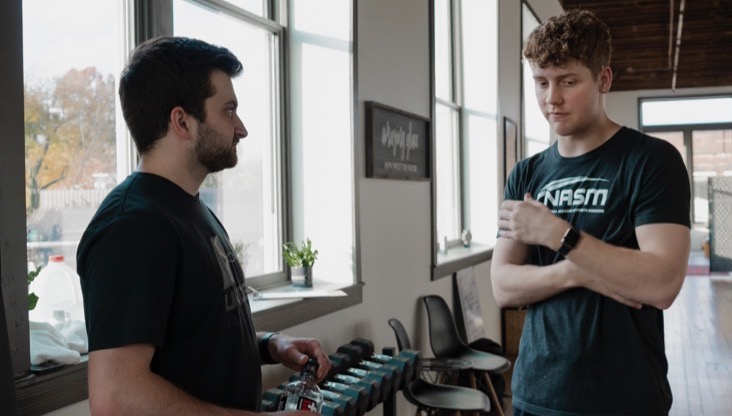
Networking is a fantastic way to expand your knowledge, build relationships that could last for years (or decades), and gain some exposure.
For one, networking allows you to exchange ideas with other trainers, learn how they do things, and pick up valuable insights.
Second, connecting with other trainers can be a great way to build relationships that could lead to:
- Mutual client referrals (if either coach is overbooked or unable to help someone)
- Collaboration opportunities (such as hosting a weekend retreat or fitness challenge together)
- Learning (and sharing what you know) about continued education opportunities
- Getting and providing feedback for mutual success
- Sharing resources like textbooks, access to digital study platforms, and scientific journals
One way to network is through social media platforms like Instagram and LinkedIn. You can share others’ content with your followers, leave comments, and reach out occasionally with encouraging messages like, “Thank you for this! I learned a lot and will share it with my followers.”
You can also attend industry events that draw other fitness professionals. This allows you to talk with all kinds of people, exchange contact information (you can give out business cards), and stay in touch afterward.
But above all else, be genuine and authentic. Don’t always approach interactions with the “What’s in it for me?” mindset. Sometimes, it’s just about meeting great people and conversing casually.
Also, when reaching out and looking for something, provide value because networking is a two-way street. As the saying goes, give and you shall receive.
Gain Credibility Through Testimonials

Testimonials are written or recorded statements of praise from clients about you and your services. They have immense value, and you should start collecting them from day one.
A testimonial from a happy client, ideally one outlining the results they’ve gotten and what they’ve liked about working with you, can have a profound positive impact. For example, here are some testimonials from happy Hevy app users:
Testimonials are simply a form of social proof, which ties into the fact that people copy the actions of others and are influenced by their opinions.
Think about the last time you bought something online. How did you go about it? Like most, you probably did some research to determine what product you wanted to buy.
You then sought reviews and discussion boards online to determine the product’s overall quality and reliability before placing an order.
Finally, you purchased the product that best met your needs and had numerous positive reviews.
The same goes for personal training. Being in shape, displaying your expertise, and not being too sales-pitchy are good tactics, but more is needed. Having clients who vouch for you can make people more likely to choose your services over someone else’s.
Getting your first testimonials can be a challenge because it’s a bit of a catch-22: testimonials can help you land clients, but you need clients to get testimonials.
The good news is that everyone starts somewhere, and you will eventually get your first handful of clients. From there, it’s just a matter of providing the best possible service and asking each client to share a few words of praise once they reach a bigger goal.
Chapter 5: Experiment, Test, and Learn
This chapter teaches you what productive client-trainer relationships are, how to develop them, and what you must do to keep clients happy, engaged, and motivated.
The Fundamentals of a Productive Relationship
A productive client-trainer relationship is a win-win situation where both parties feel valued, respected, and understood.
To achieve that with your clients, you must maintain open communication, be honest, set the right expectations, and share the same commitment to reaching fitness goals together.
It starts with the initial consultation or interview. Here, you sit down with the client and have a friendly conversation. This is also an excellent time to present them with a questionnaire that includes medical, health, and lifestyle questions.
The goal is to learn about your clients, where they come from, what they expect to achieve, and their fitness training preferences. It also provides them an opportunity to learn a bit about who you are, what your coaching methods are, and how much you charge.
At this point, you may conclude that you cannot help a prospective client or prefer not to be involved with them. This is part of the process, so don’t feel bad about turning some people away.
For instance, a client might need specialized help, which you may be unable to provide. The client may also be difficult and demand too much from you. As you gain experience, you will learn to gauge prospective clients better and determine who might not be a good fit for you.
Once you’ve had the initial meeting with a client and have decided to start working with them, you must perform a fitness assessment to determine what they can do. This is crucial for understanding their limitations and creating a good workout plan.
Then, it’s a matter of serving clients as best as possible and helping them stay motivated. Here are some tips:
- Challenge them enough but not to the point where they feel overtrained or burned out
- Be patient and understand that everyone progresses at a unique speed
- Help them set S.M.A.R.T. (specific, measurable, attainable, relevant, and time-bound) goals
- Keep clients involved in the process: ask about their workout preferences, explain some of your training decisions, and help them figure out which exercises they like best
- Be flexible by adjusting your client’s workout difficulty based on how they feel; it’s not always about pushing through and hitting new records
- Teach your clients to value the process and consistency over the results and perfection––for example, set a goal to complete at least 90% of the workouts for the month; doing so teaches them to value the process more than an arbitrary outcome
You can learn more about these (including the four crucial mistakes to avoid) in our article on client motivation.
Create the Best Training Programs Possible
Creating effective workout programs for your clients is essential for keeping them engaged and motivated. You may be the kindest, most thoughtful, and empathic trainer, but you will struggle to retain clients if you can’t help them get the desired results.
Writing programs for clients can be a nerve-racking experience for new coaches because:
- What if your plan is no good?
- What if they don’t see results from it?
- What if the workout plan is so bad that the client laughs at you, calls you stupid, stops working with you, and tells everyone you’re a fraud?
First, calm down.
Second, most trainers feel that way at first because it’s one thing to write workout programs for yourself and another to do so for other people. You can’t always know how a client will feel about a training program and whether it will be good for them.
But that’s the thing:
You can’t know. All you can do is make an educated guess based on the information you gathered during the initial interview, along with the questionnaire and assessment.
An experienced trainer can make a better guess, but it’s still a guess.
So, rather than obsessing over the workout plan and making it perfect from the start, create something that fits your client’s needs and tweak it afterward.
Listen to their feedback, see how they respond to the plan, and track their progress to determine the overall effectiveness of the plan.
You may need to add or remove sets, change some exercises, tweak their weekly schedule, lengthen or shorten their rest periods, or something else.
(As a side note, Hevy Coach allows you to create and assign workout programs for your clients and easily tweak each workout when needed.)
As a new trainer, you may choose to create each program from scratch to build some experience and confidence. You can then start using templates to streamline the process and save time without sacrificing the quality and effectiveness of training programs.
Check out our handy guide on fitness programming and the eight steps you should follow.

Try Hevy Coach
Intuitive personal trainer software, with a world class experience for your clients.
30 day free trial, no credit card required
Chapter 6: Specializations, Career Advancement, and Standing Out
This chapter explains how the mandatory recertification process works, what specializations you may consider to coach specific populations, how to advance your career beyond one-on-one personal training, and how to stand out.
Continue Learning and Maintaining Your Certification
Earning your certification is the first step, but being a personal trainer is a journey of growth and learning to expand your toolbox, serve clients better, and be more prepared to tackle unexpected problems.
Part of learning and growing as a fitness professional means collecting continuing education units (CEUs) or continuing education credits (CECs), which are essential for getting recertified when the time comes.
To clarify, CEUs and CECs are pretty similar, as both measure a person’s continuing education and eligibility for recertification.
One hour of active participation in an approved study program generally equates to 0.1 CEUs. So, you’d typically need to complete ten hours of course material to get one CEU.
Most organizations (e.g., NASM) will have you go through the process every two to three years to ensure you’re up-to-date with the latest best practices in the industry and continue expanding your knowledge and skill set.
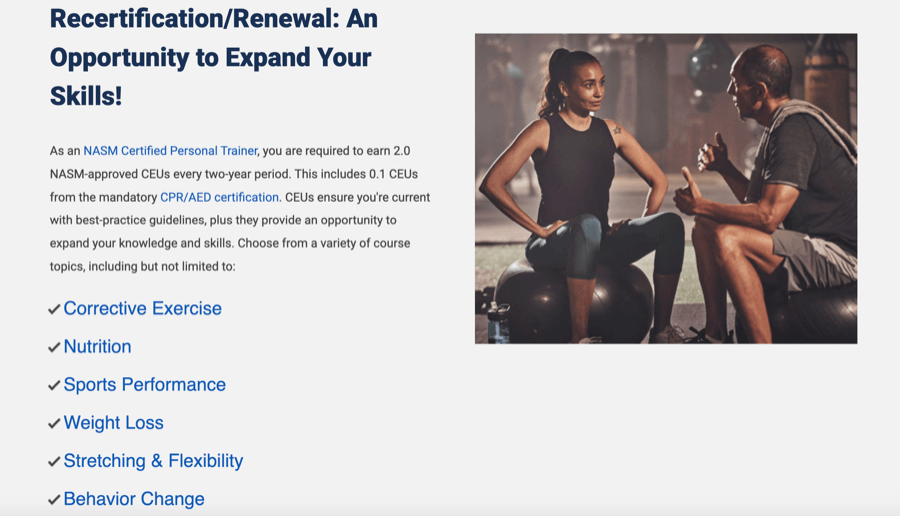
While that may seem complicated, it’s not. It goes like this:
- You complete the process we outlined above to earn your certification.
- You then have one to three years to collect your CEUs or CECs.
- Once collected, navigate your organization’s website to find the recertification option (typically under Continuing Education or similar) and submit digital copies of the documents.
- You will then have to pay the recertification fee (yes, there’s a fee), which is typically around $100.
- Wait to be approved and for your certification to be renewed.
This is what the process looks like, but you should check with your certification organization to see their unique requirements and how often you would need to get recertified.
You can read more about the recertification process of the programs discussed above at the following links:
- ACE – every two years; $129 recertification fee
- ACSM – every three years; $55 recertification fee
- ISSA – every two years; $0 if you get all CEUs through ISSA and $99 if not
- NASM – every two years; $99 recertification fee
- NCSF – every two years; $85 recertification fee
- NSCA – every three years; $35-65 for members or $60-90 for non-members
But how do you collect these CEUs or CECs?
Each certification organization offers courses you can complete for CEUs or CECs. They also have a list of approved third-party providers.
For example, NASM has a list of continuing education courses, which you can see here. They also have a list of approved third-party courses, shown here.

NASM even offers a ‘Recertify For Life’ program, which costs $399 and allows you to renew your certification (applies only to NASM credentials) an unlimited number of times. This can save you a lot of money in the long run, especially if you plan to be a personal trainer for at least a decade.
The program also comes with 30% discounts on NASM specializations, workshops, and their Business Blueprint course.
Lastly, while personal training course materials offer a lot of value and are necessary for passing the CPT exam, that doesn’t mean you have to limit yourself to just these sources.
There are other ways to learn valuable lessons about coaching clients, writing programs, and running a personal training business. Good options include personal trainer podcasts, books, and research reviews (like Monthly Applications in Strength Sports) to stay up-to-date with some of the latest scientific findings.
Specializing in Training People with Unique Needs
An overlooked benefit of becoming a personal trainer is that it creates many opportunities to specialize and help people in unique situations or with specific needs.
Let’s take a brief look at some specialization options:
Senior Fitness Instructor
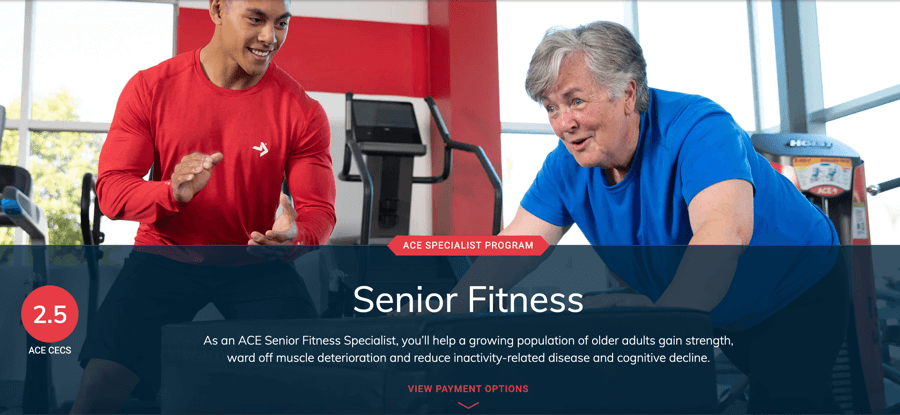
Senior fitness is growing in popularity, with research showing numerous health benefits of regular physical activity for older adults––most notably, improved bone health, better balance and a lower risk of falls, stronger muscles, and fewer chronic aches.
While you can work with older clients semi-regularly with a basic certification, getting a senior fitness instructor certification is best if you’re looking to specialize.
This will help you better serve older clients, write more effective training plans, and better understand the common chronic conditions that may impact their mobility and cardio.
ISSA, ACE, and NASM offer this certification.
Functional Training Specialist
Deconditioned individuals are those with impaired physical function due to prolonged inactivity as a result of an illness or injury or simply because of an extremely inactive lifestyle.
Such people often need help from a specialist to regain their physical capabilities, increase their activity level, improve their health, and become more independent in their daily lives.
While there isn’t certification aimed at that specific population, functional training is close, as it educates you about better and more efficient movement, how to limit pain, and how to engage the core musculature properly.
ACE and ISSA are the only organizations currently offering this. The ISSA, NASM, and NSCA PT certification programs may be better, as they provide a more comprehensive overview of working with different kinds of people.
Weight Loss Specialist
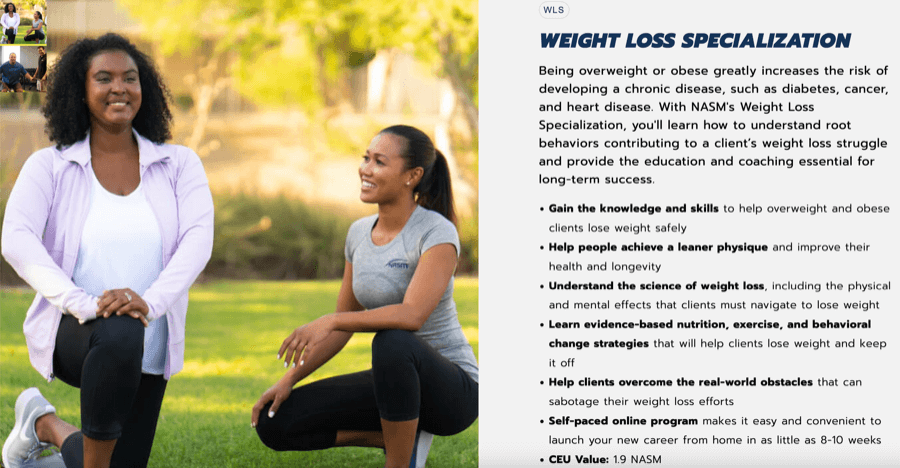
A large percentage of people embark on their fitness journey to lose excess weight, reduce the strain on their joints, have more energy, and feel better about themselves.
Whether you specialize or not, a significant percentage of your personal training clients will likely be overweight and need a solid weight loss plan.
Because of that, we recommended getting a nutrition certification alongside your training credentials back in Chapter 2.
However, these may not be enough if you want to specialize in the field and even work with at-risk populations, such as obese individuals.
ACE, ISSA, and NASM provide specialization options to expand your knowledge and skillset in this area.
Corrective Exercise Specialist
Corrective exercise is crucial for helping clients improve movement patterns, perform at their best, and stay injury-free.
A corrective exercise specialist certification will equip you with the knowledge and skills to break down movement patterns, spot mistakes and inefficiencies, and pinpoint weaknesses.
You will be able to create training plans with specific focus points and help clients overcome the physical issues that hold them back.
ISSA, ACE, and NASM offer such specialization programs.
Physique & Bodybuilding Coach
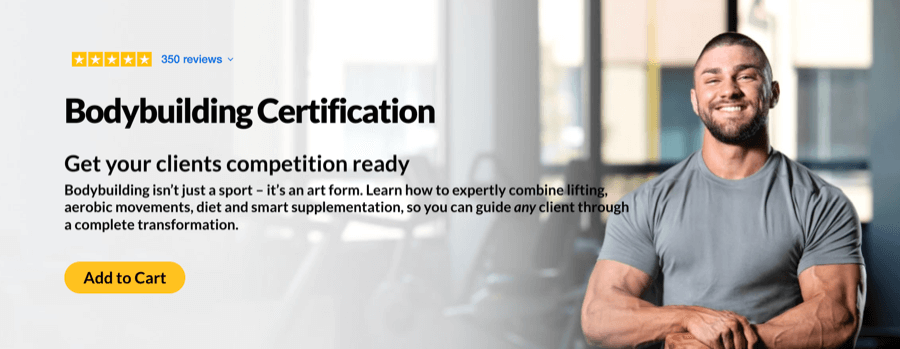
Do you aspire to be the next Hany Rambod or Joe Benett, help your clients sculpt the physiques of Greek Gods and Goddesses, and watch them conquer bodybuilding competitions? If so, consider a physique and bodybuilding coaching certification.
Such coaching certifications will help you learn crucial details about muscle growth, creating symmetry and proportion, how to structure a bodybuilding diet during the off-season and in contest prep, and how to avoid injuries.
ISSA and NASM are the only organizations currently offering this certification.
Career Advancement Options
As discussed earlier in our guide, a PT certification could be your first step, but there is much room to grow.
One option is to specialize and help people with specific needs––we outlined some of the popular options in the previous point. However, that’s not all.
There are numerous ways to branch out, offer services beyond in-person coaching, and do business. Let’s see:
Launch a Personal Training Business
Working at an established gym is an excellent way to start, but it doesn’t mean you must work for someone else forever. A natural next step for many fitness professionals is to go into business for themselves.
There are several ways to go about it:
- Rent a small studio and offer personalized one-on-one coaching
- Rent a larger studio and do group fitness coaching
- Launch a home personal training business where you go to clients’ homes or they visit yours
- Offer nutrition or wellness consultancy
Related article: How to Start a Personal Training Business in 7 Steps
Consider Online Personal Training
Online personal training is another option worth considering. It provides several distinct advantages:
- Freedom to work with people worldwide
- More work flexibility
- Choosing between multiple coaching options (e.g., virtual sessions, monthly training and nutrition guidance, selling workout and meal plans, and online group classes)
- The ability to work with more clients and earn more money
The good thing about this approach is that you don’t have to transition entirely from the start and hope for the best. You can continue to work with clients in person while recruiting online clients.
It will take a while to get used to coaching people online, so treat that as an opportunity to learn and recognize the limitations.
You can also offer hybrid personal training to some of your current clients. Instead of meeting up for coaching sessions several times per week, provide most of the guidance online and only meet up occasionally to review their form and see how they are doing.

Try Hevy Coach
Intuitive personal trainer software, with a world class experience for your clients.
30 day free trial, no credit card required
Enroll for an Advanced Degree
While an advanced degree is unnecessary to work as a personal trainer, earning one would provide higher-paying career opportunities, allowing you to work with athletes and patients needing rehab.
For instance, a physical therapist earns almost twice as much as a personal trainer ($52,64 hourly or $87.305 annually), according to Indeed.com.
Additionally, an advanced degree in exercise science, sports nutrition, or kinesiology will deepen your understanding of the human body and how it works. It will allow you to understand injuries (and how to treat them), pain and pain management, human metabolism, and diseases.
Standing Out in a Crowd of Personal Trainers
Personal training is a competitive field. An estimated 330,000 personal trainers and instructors were employed in the US in 2022.
Given the relatively low entry barrier, aspiring professionals often see personal training as the first step in their careers, which means the competition for entry-level jobs is high.
As such, the best way to prosper and advance in your career is to find ways to stand out in a crowd. Here are a few tips:
- Never stop learning. In addition to collecting CEUs for recertification purposes, you should read books, attend seminars, and network with other professionals to soak up new ideas, see how others do business and coach clients.
- Learn about nutrition. As discussed above, being knowledgeable about nutrition, calculating clients’ calorie and macronutrient needs, and creating meal plans is an effective way to serve them better, earn more, and set yourself apart.
Training and nutrition go hand-in-hand, so it doesn’t make sense to only focus on the former and hope that clients can figure out the latter. - Choose a niche. This is not something you should do as soon as you start work as a personal trainer, but it’s worth considering in the long run. Finding ways to differentiate yourself makes it easier to be known as the guy or gal who can help certain people in a unique situation.
For example, Katrina Hausmann is a fitness coach specializing in postpartum (after birth), helping women restore their fitness and core strength. - Build your online presence. We discussed this in Chapter 4, but it bears repeating because it’s a fantastic way to gain credibility, build a reputation in the industry, and set yourself apart.
Plus, by establishing an online presence, you open yourself to new opportunities, such as online coaching and selling digital products. - Offer something different. In-person training hasn’t changed much because it works. That said, just because people do something and it works doesn’t mean there can’t be better alternatives.
Don’t be afraid to experiment with pricing structures, incentive programs, online ventures, and coaching options (e.g., online, at-home, and hybrid).
Conclusion
A career as a personal trainer can be incredibly fulfilling as it allows you to help others and lead them through the complexities of fitness.
The good news is that getting started isn’t as difficult as some may have you believe. It all boils down to picking a certification program, enrolling, preparing for the exam with the study materials, and passing.
Of course, that sounds easier said than done, but it’s doable. The work that comes after is more challenging, as it requires constant learning, adapting to each client, and finding solutions to seemingly unsolvable issues.
But, if you’re passionate about fitness and love to help others achieve their goals, every step of the process will be fulfilling.
Looking for a personal training solution to coach your clients, assign training plans with ease, and more easily track their performance and adherence? If so, check out Hevy Coach––our all-in-one platform for trainers and coaches.
With it, you can quickly assemble workout plans, assign them to as many clients as you want, and track how everyone is doing from a single dashboard.
FAQs
1. What qualifications do I need to become a personal trainer?
You need a personal training certification, which you can get from ACE, ISSA, NASM, and other reputable organizations. Enrolling in such a program requires a high school diploma and CPR/AED certification.
2. How long does it take to become a certified personal trainer?
It generally takes three to nine months to review the course material and prepare for the final exam. Most people can expect to earn a certification within four or five months.
3. Can I be a personal trainer without a certification?
While no laws require trainers to earn a certification, having one makes it easier to land a decent job. Potential employers are far less likely to consider you if you don’t have a certification.
4. Is a degree in exercise or sports science necessary?
No, you don’t need a degree in exercise, nutrition, or sports science to work as a personal trainer.
5. How much can I earn as a personal trainer?
The average base salary for personal trainers in the US is $27,86 per hour or $45.095 per year.
6. Is insurance necessary for personal trainers?
Many gyms will require you to have liability insurance before you can start work. Additionally, insurance offers legal protection if a client takes legal action against you because they are dissatisfied with the results or get injured during training.
7. How important is nutrition knowledge in personal training?
Nutrition knowledge is mandatory for personal trainers to provide the best possible guidance and answer clients’ questions.
8. How hard is it to become a personal trainer?
It’s not the most difficult job to get, but it requires some dedication and focus to prepare and pass the exam. The pass rate of the final exam is around 65-70% on most certification programs.
9. What are some career paths for personal trainers?
Personal trainers can eventually become group fitness instructors, online coaches, and nutrition and wellness experts. They can also launch independent businesses, specialize in certain fields (e.g., corrective exercise), and even advance into roles like gym managers.
10. Do I need a personal trainer license?
There is no such thing as a personal training ‘license.’ However, it’s best to attain a certification to increase your chance of landing a good job and boost your credibility among prospective clients.




